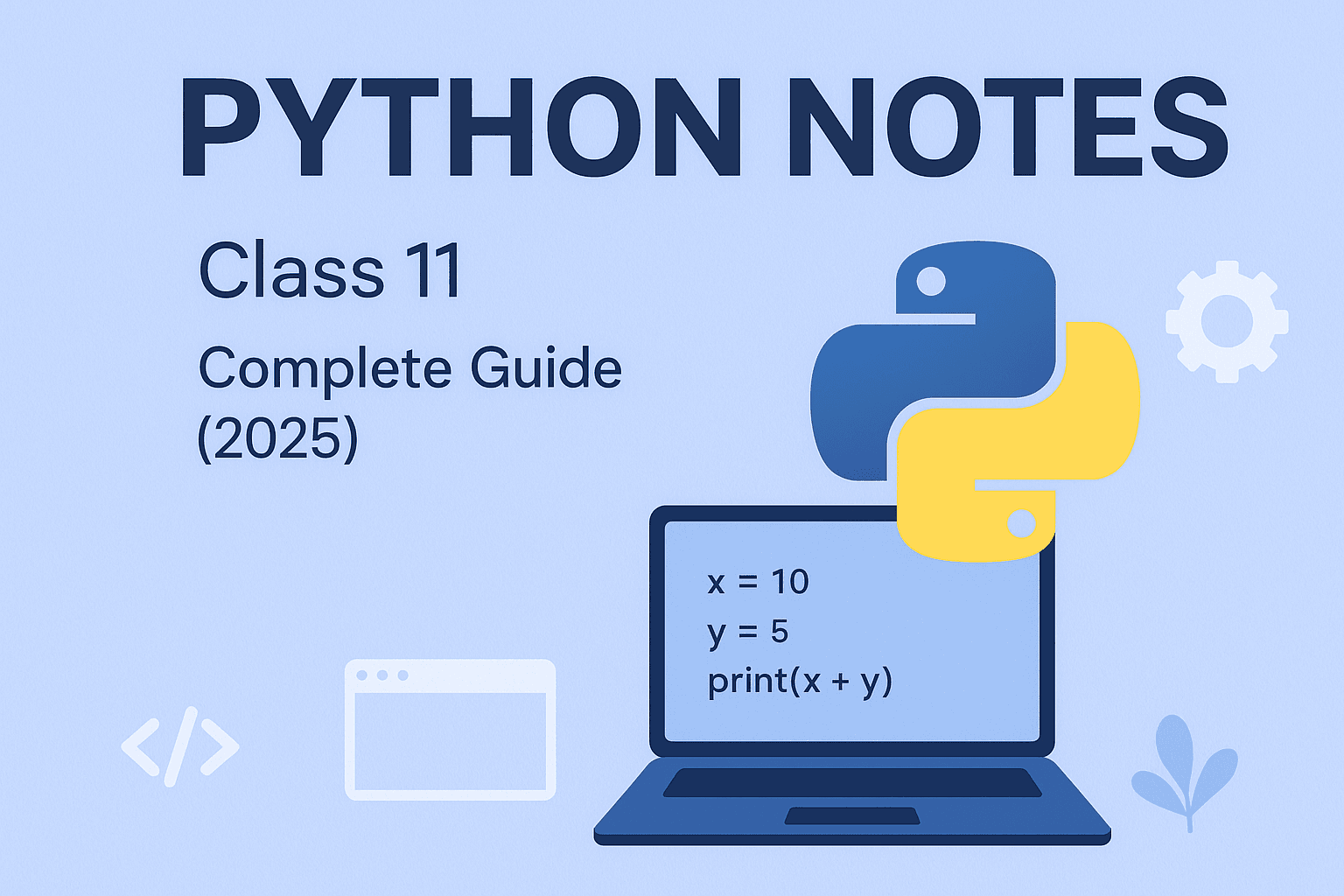Python is one of the easiest and most powerful programming languages for beginners. That’s exactly why CBSE includes Python in the Class 11 Computer Science syllabus. Whether you dream of becoming a software engineer, data scientist, or web developer, Python is the best place to start.
It’s simple, readable, and works everywhere — from school projects to big companies like Google, Netflix, and NASA. These Class 11 Python notes will help you understand every concept clearly, with examples you can actually relate to.
If you’re preparing for your exams or just starting with coding, this guide — along with the downloadable Class 11 Python Notes PDF — will make things much easier.
1. Introduction to Python
1.1 What is Python?
Python is a high-level, interpreted, and object-oriented programming language. It’s designed to be simple and readable, which makes it perfect for students learning coding for the first time.
-
Developed by: Guido van Rossum in 1991
-
Key Features:
-
Easy to read and write
-
Open-source and free
-
Cross-platform support (Windows, Mac, Linux)
-
Huge library support (for AI, Data Science, Web Apps, etc.)
-
1.2 Importance in Accounting and Business
Python isn’t just for coders — it’s used in business analytics, automation, and even accounting. For students, it develops logical thinking and problem-solving skills that apply to every field.
2. Python Basics (Class 11 Overview)
Let’s start with the building blocks of Python.
2.1 Variables and Data Types
A variable is like a container that stores data. You don’t need to declare its type — Python figures it out automatically.
Common Data Types:
-
int→ whole numbers (10, -5) -
float→ decimal numbers (3.14, -0.5) -
str→ text or characters (“Hello”) -
bool→ True or False
2.2 Input and Output
Use input() to get user data and print() to display output.
3. Operators in Python
Operators perform actions on values and variables.
| Type | Example | Description |
|---|---|---|
| Arithmetic | +, -, *, /, //, % | Mathematical operations |
| Relational | ==, !=, >, < | Compare two values |
| Logical | and, or, not | Combine conditions |
| Assignment | =, +=, -= | Assign and update values |
Example:
4. Control Statements
Control statements help your program make decisions or repeat tasks.
4.1 If-Else Conditions
4.2 Loops
-
For Loop – repeats a block of code for a specific range
-
While Loop – repeats until a condition becomes false
Example:
5. Strings and Lists
5.1 Strings
Strings are sequences of characters enclosed in quotes.
5.2 Lists
Lists can store multiple values in one variable.
6. Functions
Functions are reusable blocks of code that perform specific tasks.
Why use functions?
-
Reusability
-
Cleaner code
-
Easier debugging
7. File Handling
Even at Class 11 level, basic file handling is introduced to understand how data is stored and read.
Example: Writing and Reading a File
8. Practical Programs for Class 11
Here are some common practice programs asked in Class 11 exams:
-
Find the largest of three numbers
-
Check if a number is even or odd
-
Count vowels in a string
9. Tips for Exam Preparation
-
Practice daily – Don’t just read theory, run every example.
-
Understand logic – Python focuses more on logic than memorizing syntax.
-
Write and debug – Learning happens when you fix errors yourself.
-
Refer CBSE sample papers – Many programs are based on real exam patterns.
10. Common Mistakes to Avoid
-
Using wrong indentation (Python is sensitive to spaces)
-
Forgetting colons (:) after if, for, while, def
-
Mixing up data types (string vs integer)
-
Ignoring error messages — they help you fix bugs quickly
11. Why These Notes Help You
These Python Class 11 Notes are designed to make coding simple and visual.
Each topic is arranged in the same order as your school syllabus, so you can study faster and prepare smarter. You’ll find clear definitions, code samples, and common exam programs — all explained in a way that’s easy to remember.
And if you want to go deeper, you can always explore Tally, HTML, or Web Development courses offered at Webdox Computer Institute to build real-world coding skills.
12. Download Python Class 11 Notes PDF
You can download the complete Class 11 Python Notes PDF here .
It includes all topics with detailed explanations, programs, and extra practice exercises.
Conclusion
Learning Python in Class 11 is more than just scoring marks — it’s the first step toward real programming. The best part? Python will stay useful even after school, in college and in your career.
With these Python Class 11 Notes from Webdox, you’ll have everything in one place — from theory and syntax to hands-on examples and practical exercises.
Keep coding, keep experimenting, and remember: every great programmer once started right where you are.

